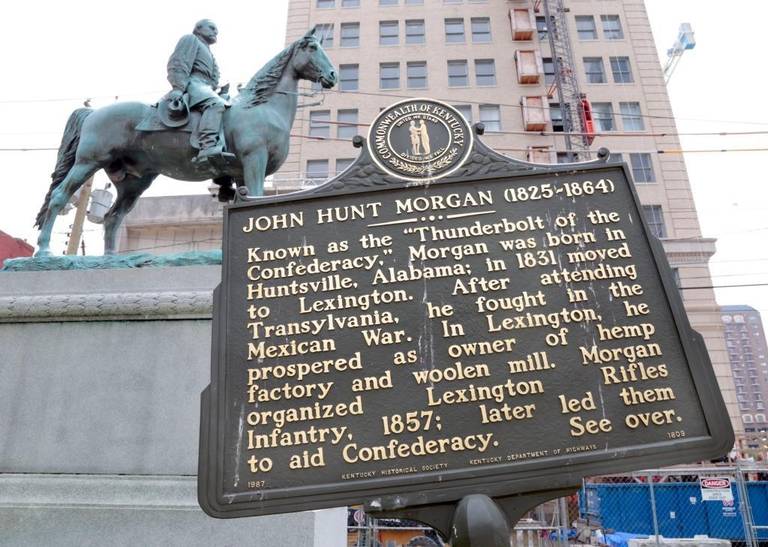Since Dear Leader Trump’s recent comments regarding the Charlottesville demonstrations and related violence, I’ve seen many people on my social media channels offering a defense of the Confederate monuments. (Supplemented with bogus stories about the Confederate flag.)
First, an overview of where I stand on some related matters:
- I’m heartfelt advocate of freedom of speech, and that means unpopular speech, even speech that qualifies as ‘hate’ speech. Now, there are nuances to be explored here, such as: speech that incites violence and concerns about censorship from public media companies such as Google and Facebook that would be worth a post by themselves. It isn’t popular speech that needs protecting, it’s unpopular speech that needs the protection. But in short: I support the right of the KKK and similar hate filled groups to peacefully protest, write and speak and the best way to eliminate this speech is by the propagation of better ideas.
- I’m against the mob actions where confederate statues are pulled down and destroyed, in ignorance or willful disregard of the civilized processes of a democracy You may be right, that a statue is offense, or you may be the taliban. – Be cautious in forcing your ideas onto others: you might be right today but you might be wrong tomorrow and then your mistakes are doubled.
Remastered Ghosts of the Past
Those points made, these monuments that celebrate the Confederacy and those who lead the rebellion need to be removed or at least recontextualized from their places of commemoration.
History cannot be erased, only our memory of it and it’s very fair to be concerned when we look to modify or update markers of the past. But similarly, we must evaluate if those markers are accurate, or just. Such is the case with the heroic depictions of Confederacy.
There were certainly brave people within the Confederacy. And there were no doubt many who fought from a sense of family and a type of tribalism. But the enterprise of the Confederacy as a whole was evil: it existed with the goal of continuing some 245 years of slavery in North America and any attempt at beatification of this monstrous, generational crime is the real attempt to whitewash history.
Jefferson Slaves
At Trump’s press conference he rhetorically asked: “This week it’s Robert E. Lee. I noticed that Stonewall Jackson is coming down. I wonder, is George Washington next week and is it Thomas Jefferson the week after? You really do have to ask yourself: ‘Where does it stop?‘”
Jefferson (one of my favorite founders, I’ll note) was a slave owner. So, how do I square that with memorial’s to Jefferson? (Or Washington, etc.)
The difference being: there aren’t memorial’s celebrating Jefferson as a slave owner. In fact, if you visit Monticello you’ll find lessons acknowledging this fact and this miscarriage of his ideals.
Jefferson failed on the question of slavery when peers of his time did not, (including one of my other favorites, Thomas Paine).
But we don’t celebrate Jefferson for owning slaves. We celebrate Jefferson for the formulation of ideas that were better than the individual. – We don’t rebuke history, we look at it with a steady eye and honest heart: the good and the bad, so that we can learn from both.
History Lesson
At the end of World War II, the Germans took down the memorials of the 3rd Reich, placing them in museums and providing education around others.
We can learn from this. – Take the most noteworthy pieces, and place them in museums or grounds that provide context. Explain the history of the Confederacy, their leaders and the root cause: Slavery. (Those that aren’t of note can be stored for future consideration.)
The German’s don’t have Hitler Highschool, and neither should we.
Still disagree? What about this Kentucky memorial to Confederate General John Hunt Morgan. – It’s a nice looking piece of sculpture: cutting a nobel figure, complete with a plaque giving the visitor a synopsis of his history. What else would want to know? Why be such sensitive snowflakes about this harmless statue?
 How about the fact that the statue stands on one of the largest slave markets in the South? – How many people were torn from their homes, their loved ones, shackled and held as lifelong forced labor prisoners who’d committed no crime on this very ground? And what do we see? – A handsome depiction of a nobel Confederate General on his mighty steed – an enforcer for slave masters. Imagine if your grandparents, and their parents and their parents had been slaves and you had to walk past a statue celebrating their captors on the very grounds where they’re lives had been sold. Many of our fellow American’s don’t have to imagine.
How about the fact that the statue stands on one of the largest slave markets in the South? – How many people were torn from their homes, their loved ones, shackled and held as lifelong forced labor prisoners who’d committed no crime on this very ground? And what do we see? – A handsome depiction of a nobel Confederate General on his mighty steed – an enforcer for slave masters. Imagine if your grandparents, and their parents and their parents had been slaves and you had to walk past a statue celebrating their captors on the very grounds where they’re lives had been sold. Many of our fellow American’s don’t have to imagine.
Don’t kid yourselves, these statues tell lies but it’s not too late to set the record straight.


Recent Comments